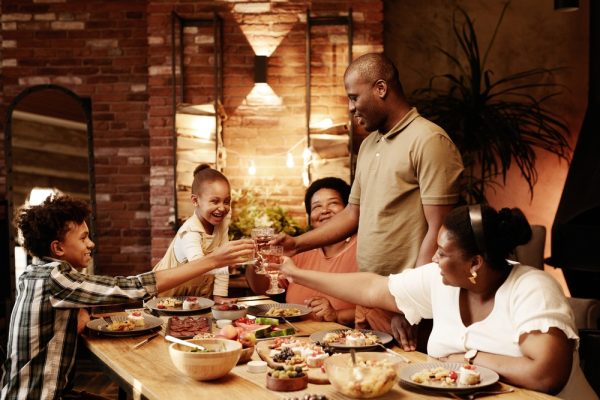
“Does not work for all families. Ask any child of an alcoholic.”
That heartbreaking comment was left on one of our social media posts about positive, supportive family mealtimes. And it’s not the only one. Over the years, we’ve heard from hundreds of people about their unpleasant, upsetting, and even traumatic experiences with family dinners – many of which included alcohol or substance abuse.
On the other side of the coin is the research that shows family meals can be protective against the development of substance use disorders. Teens who regularly eat with their families tend to have lower rates of drug and alcohol use, misuse, and use disorders than their peers who don’t engage in family mealtimes. And although there are no current studies on rates of alcohol and drug use among adults who engage in shared meals, we do know that eating with others decreases loneliness, improves mental health, and can contribute to greater marital satisfaction. Each of these benefits may offer protective qualities against the development of substance use disorders.
So, when current heavy misuse of substances is a factor, family meals may be unsafe and counterproductive; but when it’s not, eating together may contribute to keeping it at bay. Since October is Substance Abuse Prevention Month, we wanted to learn more about the role of shared meals in potentially decreasing risk, and how parents might handle both discussing and modeling behaviors around alcohol use at the table.
Dr. Timothy Wilens, Chief of the Division of Child and Adolescent Psychiatry and Co-Director of the Center for Addiction Medicine at Massachusetts General Hospital, notes that the data around risk reduction through family meals show “very strong signals…(Family dinners) are among the most robust preventive factors for the development of substance use/use disorders – one of the most feared outcomes families deal with in children growing up.” He points to the research done by CASA Columbia, which compares teens who eat with their families 5-7 nights per week on average against teens who eat with their families fewer than 2-3 nights per week. The research demonstrates that teens who eat fewer family meals are “almost four times likelier to use tobacco; more than twice as likely to use alcohol; two-and-a-half times likelier to use marijuana; and almost four times likelier to say they expect to try drugs in the future.”
But, often, alcohol use – like that glass of wine at Sunday dinner or a beer at the backyard barbecue – goes hand-in-hand with family meals. What signals might that casual use send to kids? Does drinking at dinner negate the protective value of family dinner? Dr. Wilens says not necessarily. He stresses that if the household is free of any substance use disorders or violent behaviors, there’s little evidence to suggest that simply having an alcoholic beverage with dinner will increase kids’ risk of misusing substances. In fact, he points out, some professionals theorize that modeling “responsible” drinking may be helpful.
There’s a big caveat, though. “Parents who have current or past histories with alcohol use disorders place their children at a four-to-six-fold increased risk for problems with alcohol that seem to stem from both genetics and family modeling,” Dr. Wilens says. “I would advise against any drinking in these households.” He shares that when parents who have a history of substance use disorders drink in front of their children, particularly during the tween and teen years, the risk of those children developing a problem with substance use at some point increases substantially.
In any case, Dr. Wilens advocates for clear communication and open conversation around alcohol and other substances, including vapes, marijuana, opioids, and prescription medications like stimulants and relaxants, which can be easily misused. He notes that listening to kids and teens may help open up the conversation. What are your teens saying about alcohol, for example? Does it seem like their peer group might be involved with drinking or vaping? “Discussing difficulties with excess alcohol, driving and alcohol, blackouts, potential traumatic events, and school or legal implications can help young people be educated about potential risks,” he says. “Don’t be afraid to repeat and repeat! When kids start saying back to their parents what the parents have said a million times, that’s how you know the message has been internalized.”
When discussing this tricky topic with your kids, Dr. Wilens urges focusing on the reality: “Most kids don’t use drugs or alcohol, and only a minority use regularly.” He says stressing this point helps provide a “compass” for teens who may think they’ll be left out if they don’t try substances. Dr. Wilens recommends parents keep the door open for continued communication, make sure kids know they’re not weird or abnormal for not using, and help provide good coping strategies for anxiety and stress – two of the major contributors to teens using substances. And of course, we’d add the recommendation to keep having family meals, which can offer a good chance to check in regularly and keep those lines of communication open.
We’re headed into the cozy season, and this slow-cooker-friendly stew recipe is the perfect way to fit in a warm and hearty family meal even on busy nights!
Wondering how to get reluctant tweens and teens to the table in the first place? Try some of these activities that balance tech with family time.
If it’s hard to imagine getting adolescents to open up about substance use, you might want to try some of these less challenging conversation starters to begin with.
2025 The Family Dinner Project